In May 2022, we celebrated the soulful magic that emerges when bits of culture mix into something new that is greater than the sum of its parts!
story
Magic in Roux + Rues
The jumping off point for this whole event was an original song by my multi-talented friend Mike Cobb: “Dans Les Roux.” The songs title and lyrics are a play on two French phrases: dans les roux (in the roux, meaning all the things you might put into your roux which is the basis of a gumbo (among other dishes), and dans les rues (in the streets). The song, fittingly played in a New Orleans funky twang, makes it feel as we are indeed dancing the night away dans les rues like Frenchman or Bourbon streets in New Orleans.
And the verses themselves describe the steps of making and enjoying a delicious gumbo, and how to continue the fun after that. The chorus refers to a parallel, human type of gumbo which reminds us that when we come together dancing in the streets, all the fun, energy and magic of that night is necessarily the product of the energies each of us bring and throw in the pot of the experience.
Any gumbo has to start with a roux, but from there, every chef has their own recipe, each one perfectly authentic. Any night may start with a fun band, but the magic can only come when all the participants come with open hearts, ready to jump in the pot together for the fun of the night.
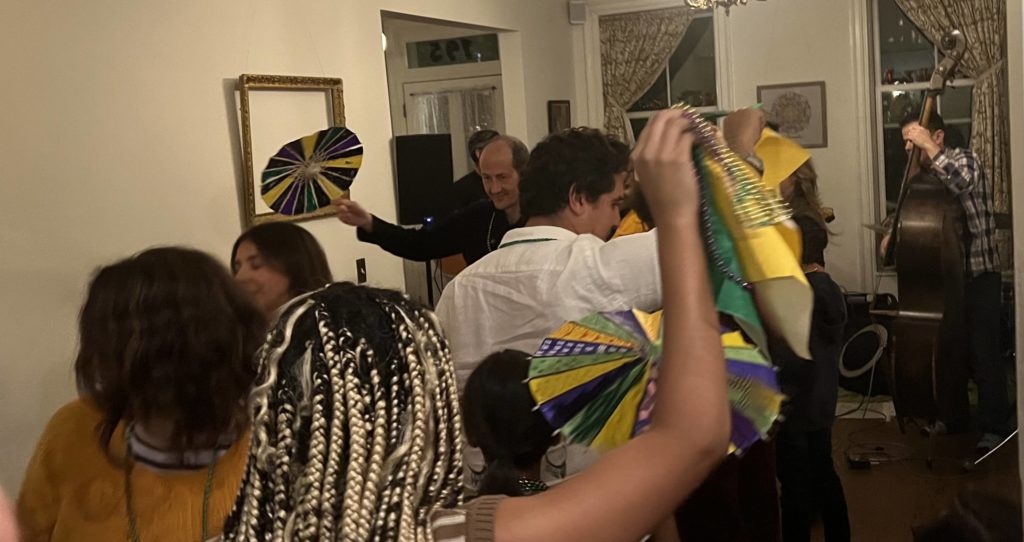
… and magic we made! We came together 7-May 2022 for some live eclecticana music by Spike and the Dredgers, all of the food and drink mentioned in Mike’s “Dans les Roux” song, plus some others, some second-line-umbrella making, and second line dancing, and LOTS of fun.
“Thank you so much for the wonderful evening. It fed my soul, my spirit, and my body.”
R. D. (Brooklyn/Paris), attendee
To taste the Mike’s metaphor – the roux he sings about – we decided to make several variations of gumbo as well as some other items mentioned in his song: red beans and rice and Sazeracs! Also per the song, we had to have some ice cold Abitas on hand, and we made our favorite pralines because we couldn’t not. Any excuse to make those deliciously addictive morsels.
Recipes for each can be found in the following sections (jump around via the “The Journey” navigation):
- Maple-paprika Pralines
- Sazerac “Punch” – a punch bowl version of Sazerac, based off Paul Gusting’s recipe
- Gumbo du Monde – adapted from C.P. Love’s version in the WWOZ cookbook That Sounds Good! (not an affiliate link!)
- Chicken & Sausage Gumbo – adapted from Chris Wells‘ version in the WWOZ cookbook That Sounds Good! (not an affiliate link!)
- Vegan Gumbo Z’herbs – adapted from the Louisiana Cookin’ recipe
- Louis Armstrong’s Red Beans & Rice
- Pralines
music
NOLA Funk + Eclecticana
We got the party started with this funky playlist; a nice aural appetizer to get our heads bopping and feet tapping. Go ahead and get that on now. We’ll wait.
Eclecticana is a term Mike came up with to capture his boundary-defying musical tastes and sensibilities. It incorporates country, blues, folk, rock, psychedelic, garage, punk, and even some tejano. A gumbo-of-a-man himself (what with is podcasts, journalism, photography), Mike has been playing around the New York Area, and internationally, with a variety of other bands for 30 years. You can follow him on Soundcloud here, and will update this post when there is a way to follow his individual
On May 7th, Mike brought a fun, new group called “Spike & the Dredgers,” which is just the latest manifestation of long time musical friendships from in and around Brooklyn. it features Matt Statler on acoustic guitar, vocals and percussion; Rip Westmoreland on guitar, vocals and mandolin; Ben Herzog on upright bass and vocals; and Scott Hamilton on drums and vocals. just before the pandemic, they began playing together as the Bootheel Boss Gobblers, another collaboration with this crew. I will be sure to update this post when I have more links to help us follow these fab musicians.
We don’t yet have a recording of the fabulous “Dans les Roux” song, but here are the lyrics and chords so you can take a crack at it if you’d like! We will add a link to the recording when it is released.

Did you already press play? WHAT? then do it, and laissez les bons temps rouler!!
story
Roux
Fittingly, gumbo not unlike good jazz; any great jazz song has a number of interpretations that have been put forth over the years, and yet each time there will be improvs and solos that will give a slightly different flair, but all with the same great base of the original song.
“Blues is like the roux in a gumbo.
People ask me if jazz always has the blues in it.
I say, if it sounds good it does.”
Wynton Marsalis
The first thing to know about gumbo is that there are as many recipes as chefs. There are three main categories, but they are by no means completely separate and distinct. Much ink has been spilled in documenting the various kinds as they evolved and influenced each other, both on large scale, and within families themselves.
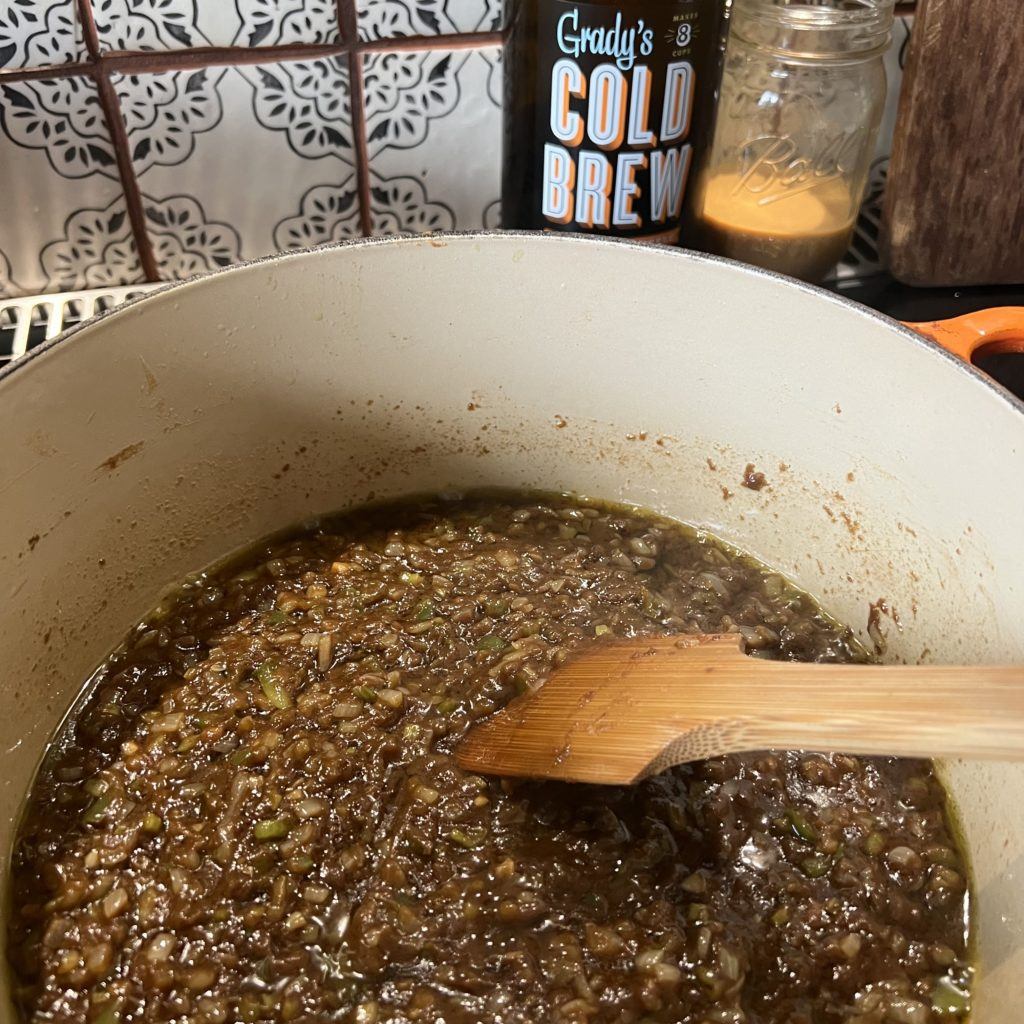
First and foremost, a roux is a basic foundation for any gumbo. A roux made by cooking flour into fat (traditionally butter or vegetable oil, and typically in a 1:1 ratio). It is a painstaking process, as you need to constantly stir it for a minimum of about 20 minutes. It can not be rushed. It is the foundation in terms of thickener and flavor.
The roux becomes progressively darker brown the more it cooks. Each chef has their desired shade (coffee with milk, peanut butter, pralines…). The darker it is, the more nutty and complex the flavor, and the deeper the color of the final product.
Then you add the aromatics – the holy trinity as it is known in New Orleans – to the roux. The holy trinity is made up of diced onions, celery and bell pepper, typically in a 2:1:1 ratio.
But then, once the foundation is set, each chef has their own recipe, and they will likely also improvise based on what they have available, and how many people they might be having to dinner. Gumbos are often divided into the cajun or creole camps, but depending on who you ask, the lines drawn around those distinctions change.
Lastly, there are the thickening agents okra vs filé for thickeners. Okra was brought over by enslaved people, and became a staple of the area. Filé is a powder made from the dried and ground leaves of the North American sassafras tree, which was introduced by the Chocktaw Native American people.
Before researching for this event, I thought that the terms cajun and creole were somewhat interchangeable when referring to cuisine and culture around New Orleans, but I was wrong! While over time they they have grown closer together, they have shared, but distinct roots. In Howard Mitcham’s “Creole Gumbo and All That Jazz” book published in 1992, he goes into great detail to describe the origin and importance of each categorization. Extremely briefly, Creole stems from the Spanish word Criollo, and refers to all the mixing of genes and traditions and cuisines beginning in the early 1600s. Cajun, on the other hand, refers to the group of Acadians who arrived in New Orleans beginning in 1765, displaced from Canada by the British in the mid 1700s when they took over. These people settled in rural areas around New Orleans, intent on continuing the simple lives sustained by farming, trapping and fishing.
“Since its roots are french, Cajun cookery is similar to Creole cookery in many ways, but with more spices, more herbs more hot peppers, and more gusto. As i’ve already said, the best way to distinguish them is to describe Creole as sophisticated city cooking, and Cajun as country cooking – less inhibited and more daring, slapdash and inventive”
Howard Mitcham in Creole Gumbo and All That Jazz
It is also important to note that the word gumbo itself traces it’s etymology both from Africa (okra was known as “ki ngombo or quingombo” by many of the enslaved people stolen from West Africa) and the Chocktaw Native people, whose word for file powder was kombos. [On a related note, you could also click over to the Malian dish called Gombos which we have captured in a portrait of Salif Keita here!]
In New Orleans, Gumbo Z’herbs was traditionally a meatless gumbo option for Catholics practicing abstaining from meat on Fridays or during Lent. But these days, you’ll often see Gumbo Z’herbs with various meats, which gumbo matriarch Leah Chase says was because they would eat it on Holy Thursday, and they needed to fill their bellies before fasting on Good Friday.
I haven’t read confirmation of this anywhere, but it also stands to reason that gumbo z’herbs has roots in the ancient dish of melokheya, known by slightly different names across North and West Africa and the middle east. We first made it in 2020 when my daughter was studying Egypt (and I went with the spelling in the novel noted in that post. Basically, it is a stew of greens, with optional meat, just like gumbo z’herbes.
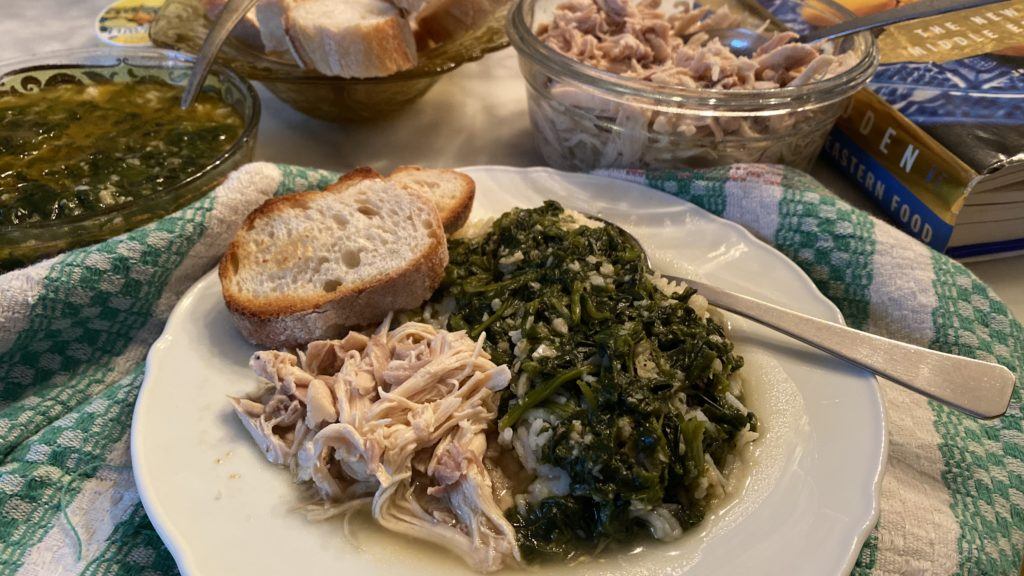
recipe
Gumbo du Monde
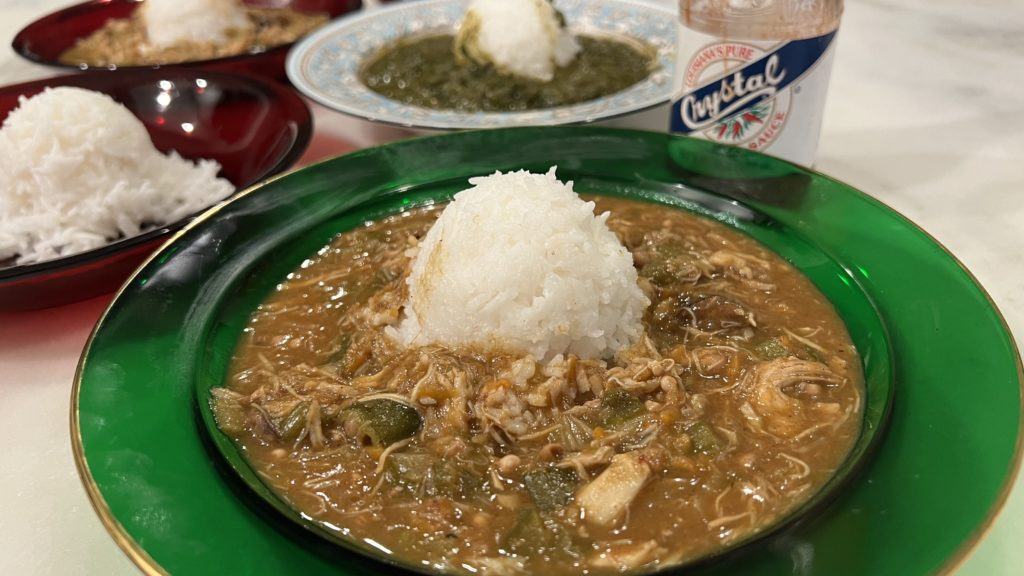
Gumbo du Monde adapted from C.P. Love’s Recipe
Ingredients
Broth
- 1 whole chicken or 6 bone-in chicken thighs
- 8 oz onions, chopped
- 4 oz carrots, chopped
- 4 oz celery and tops, chopped
- 1 head garlic, chopped horizontally in half
- 1 tsp freshly cracked black pepper
- 3 stems parsley
- 1 bay leaf
- 1/2 tsp each: thyme, tarragon, oregano and basil
- shrimp heads and shells from 4 lbs of shrimp he calls this an absolutely critical part of his gumbo but sadly we had allergies to contend with!
Roux + Gumbo
- 1 cup butter, in chunks
- 1 cup flour
Gumbo
- 4 cups onion, finely diced
- 2 cups celery, finely diced
- 2 cups green bell pepper, finely diced
- 1 bunch green onions, chopped
- 5 cloves garlic, minced
- 3 bay leaves
- creole seasoning to taste
- Tabasco sauce
- 2 lbs fresh okra, tops removed and chopped into 1/2 inch rounds or frozen, but add to gumbo more towards end, if so!
- 16 oz Andouille sausage, sliced into rounds
- 1/2 cup clam juice (our approximation from missing shrimp heads)
- 16 oz frozen crab meat
- parsley
Serving
- Crystal hot sauce
- green onions sliced (did he say how to serve)
Instructions
Broth
- Skin chicken and cut into large pieces. Prepare vegetables, and the bouquet garni
- Heat a large, heavy-bottomed pot to medium-high. When hot, add oil and brown chicken, in batches if needed so as not to crowd the pan. Add a bit of water to scrape up any browned bits. When the bottom of the pan is clear, add the remaining broth ingredients and add water to cover everything by an inch or two.. Bring to a boil, then reduce heat to a simmer, and cook for 3 hours. Skim and discard any foamy scum.
- Remove the chicken to a bowl and cover. When cool enough to handle, de-bone and break into bite-sized pieces. Toss with creole seasoning and keep aside, covered.
- Line a strainer with cheesecloth (or use a mesh sieve), and strain the remaining broth. [Note: the original recipe recommends chilling broth to skim the fat, or remove as much as possible in this straining process, but we didn’t worry too much about that and it was great.]
- This makes more stock than you will use for this gumbo, but you can freeze it for later use.
Roux + Gumbo
- Prepare yourself to be stuck at the stove for at least 45 minutes. Put some good New Orleans Tunes on (our Gumbo Playlist here!), and get a glass of whatever beverage is going to put you in the best mood for dancing while stirring (and stirring, and stirring). Depending on the time of day, this chef is probably doing red wine or Grady’s New Orleans style iced coffee (with milk and maple syrup of course).
- Heat a heavy-bottomed pan to medium. When hot, add the butter. When the bubbling subsides, add the flour and stir vigorously with a flat-head wooden spatula until well combined. Continue stirring until it is at least the color of peanut butter noting that it will continue to cook a bit darker in the next step (also see note below).
- When your nice brown color is reached, add the diced vegetables and garlic, continuing to stir until the vegetables begin to melt into the roux.
- Then add 4 cups of broth (to start), tabasco sauce and bay leaves and simmer for 45 minutes. Taste and add salt as needed.
- Meanwhile brown the sausage rounds in a bit of oil at medium-high heat. When done, remove from hot pan and keep covered until ready to use.
- Add the chopped okra, and cook for 30 minutes. Then add the chicken and sausage, crab meat and clam juice and cook for another 15 minutes. Taste for seasoning and adjust cajun seasoning, clam juice, hot sauce and salt per your liking!
- Keep warm until ready to eat, and the longer you can wait the better. The next day, slowly reheated is best.
Serve
- According to C.P. Love, this *must* be served with the rice first placed first in the center of the bowl, and the gumbo spooned around it (see note below). Optional garnish: sliced green onions and Crystal hot sauce.
Notes
recipe
Vegan Gumbo Z’herbes
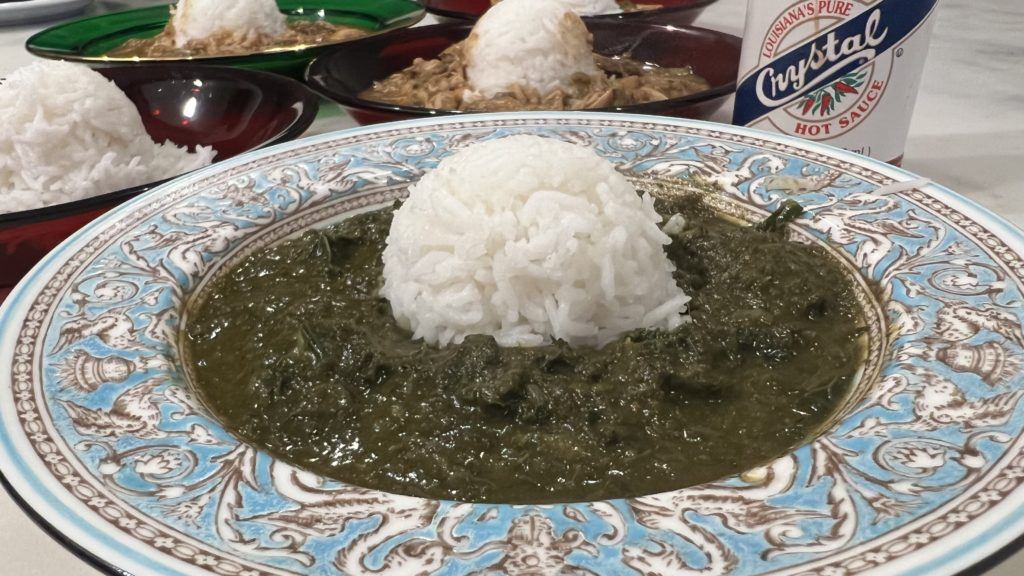
As noted above, Gumbo Z’herbs was traditionally a meatless gumbo option for Catholics practicing abstaining from meat on Fridays or during Lent, but these days, you’ll often see Gumbo Z’herbs with various meats. Best to watch Leah Chase of Dooky Chase in New Orleans to describe the importance and traditions surrounding this dish, in this video:
We wanted to use her recipe, but we needed a vegan option for our event, so we opted for a fully vegetarian version, and we substituted oil for the butter in the roux.
Vegan Gumbo Z’herbes
Equipment
- food processor
Ingredients
- 6 cups water (to start)
- 2 tbsp kosher salt
- 4 cups butterhead lettuce ~ 1 head
- 1 bunch stemmed and roughly chopped ~ 7 stems
- 12 oz kale, stemmed and roughly chopped
- 8 oz baby spinach
- 5 oz baby arugula
- 3 shallots, chopped
- 1 leek, chopped
- 1 small yellow onion, chopped
- 5 cloves minced garlic
- 4 tbsp sunflower oil
- 4 tbsp all-purpose flour
- 2 tbsp fresh parsley, chopped
- 1/2 tsp cayenne pepper
- 1 tsp filé powder, optional
Serving / Garnish
- cooked long grain rice
- fresh parsley, chopped
- Crystal Hot Sauce
- lemon wedges
Instructions
- Put water and salt in a large dutch oven and bring to a boil on high heat. Reduce to medium-high and gradually add greens, onions and garlic. When all the greens have been added and the water returns to a boil, reduce the heat to a a simmer. Cover and cook for 30 minutes, stirring occasionally.
- When done, drain well, reserving the liquid. Depending on the size of your food processor, you may need to work in batches to pulse the greens/onions until pureéd.
- Make a roux in same dutch oven: heat oil over medium heat and add flour, continually stirring with a wooden spoon or whisk. Do not stop stirring! Continue scraping and mixing until the roux becomes the color of coffee with milk.
- Whisk in 6 cups of the reserved cooking liquid to start. Whisk until smooth and then add the greens mixture. Add more liquid as needed to keep greens just covered, but not so much that the greens are floating around!
- Bring to a boil, then reduce heat and simmer for 20 minutes, stirring occasionally. Stir in parsley and cayenne pepper. Cook for an additional 40 minutes, adding water as needed to maintain consistency noted above.
- Taste and adjust salt, and add Chrystal Hot Sauce, and/or lemon juice to taste. If using, add filé powder just before serving.
- Serve spooned around a round mound of cooked rice, with Chrystal Hot Sauce and lemon wedges on the side. Pairs nicely with some sazerac or Abita beer.
recipe
Chicken & Sausage Gumbo
Chicken and Sausage Gumbo
Ingredients
Roux + Gumbo
- 8 cups chicken broth
- 16 oz andouille sausage, cut into 1/4" rounds 5 links saucisse d'Alsace was 537g
- 2 cups cooked chicken, in bite-sized pieces
- 2 cups onions, finely diced ~230g
- ~1 cup celery, finely diced ~150g
- 1 cup green bell pepper, finely diced
- 4 cloves garlic, minced
- 1 cup butter ~230g
- 1 cup flour ~230g
- 1 tsp cumin powder
- 1 tsp thyme (or herbs de provence)
- 1/2 tsp black pepper
- 1/2 tsp cayenne pepper
- 2 bay leaves
- salt
- 3 cups frozen, cut okra we would do 4
- 1/2 cup green onions, sliced
- 1/2 cup fresh parsley, chopped
Serving
- cooked long grain rice
- fresh parsley to garnish
- green onions, chopped optional
- Crystal hot sauce
Instructions
Prep
- Wash and chop all of the vegetables, and prep the remaining ingredients (particularly the stock and browned sausages) to have at the ready.
Roux + Gumbo
- As with any roux, prepare yourself to be stuck at the stove for at least 45 minutes. Put some good New Orleans tunes on (our "Dans Les Roux" playlist is here), and get a glass of whatever beverage is going to put you in the best mood for dancing while stirring (and stirring, and stirring). Depending on the time of day, this chef is probably doing red wine or Grady’s New Orleans style iced coffee (with milk and maple syrup, of course).
- Heat a heavy-bottomed pan to medium. When hot, add the butter. When the bubbling subsides, add the flour and stir vigorously with a flat-head wooden spatula until well combined. Continue stirring until it is at least the color of peanut butter, noting that it will continue to cook a bit darker in the next step (also see note below).
- When your nice brown color is reached, add the diced vegetables and garlic, continuing to stir until the vegetables begin to melt into the roux (about 20 minutes). Then add the salt, spices, herbs and sausages, and cook for 5 minutes.
- Add 5 cups of the broth (to start), bring to a boil and then reduce to a simmer for one hour, then add the chicken and okra, and simmer gently for 15 more minutes. Add broth whenever it is getting too thick or sticking to the bottom of the pan. The longer you wait to eat it, the better it will taste! But we don't blame you if you want to dive right in.
Serve
- Put a rounded scoop of hot, cooked white rice in the center of a bowl or deep dish, and spoon the gumbo around it. Garnish with chopped parsley, and pass some Crystal hot sauce.
recipe
Satchmo’s Red Beans
Louis + Lucille Armstrong’s recipe for his favorite meal: red beans and rice. I’ve made this several times thanks to finding it on WWOZ’s site for one of our many #festinginplaces, but only recently came across this gem of a video where Lucille is making it on the Mike Douglass television show.
In a blast from the past, it ends with Mike saying you could get the recipe by sending him a self-addressed, stamped envelope asking for it. Remember those days? Thanks to us and the interwebs, we have you covered, no stamps or envelopes required.
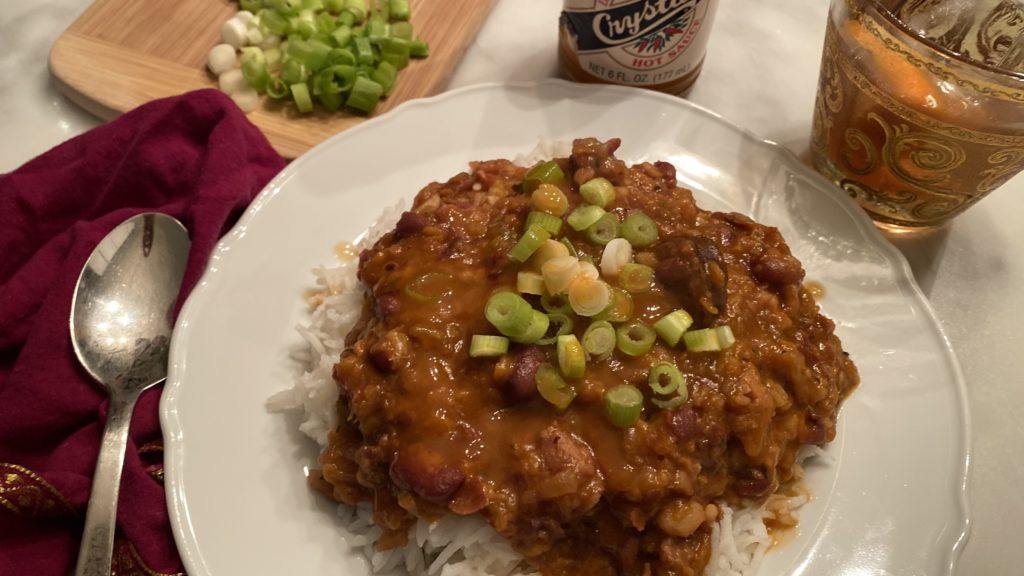
Satchmo’s Red Beans and Rice
Equipment
- large heavy-bottomed pot
Ingredients
- 1 lb dry kidney beans
- 4 ham hocks 715g jarret du porc, avec les os
- 2 cups onions, finely diced
- 1 green bell pepper, finely diced ~1 cup
- 2 clove garlic, minced
- 2 dried red peppers, seeds removed
- 1/2 lb salt pork (or pork belly) ~225g poitrine du pork, fumée
- 1 small can of tomato sauce
- ½ tsp salt, plus more to taste
Serving
- hot, cooked long grain white rice
- Crystal hot sauce our optional addition
- chopped green onions our optional addition
Instructions
- Wash beans and soak overnight in cold water, covered. Louis likes to say this step is required to "take the whistle out of them."
- Put the ham hocks in a large pot, add water until covered, and bring to a boil. Reduce heat to medium and cook for 90 minutes, adding water as needed to keep them covered.
- Meanwhile, chop the onions, pepper, garlic and salt pork.
- When the ham hocks are ready, pour off both the cooking water of the ham hocks and the the soaking water of the beans, and combine the ham hocks and beans in one large pot. Add salt pork and fresh water until the the pork and beans are covered. Bring to a boil, then reduce to a simmer, and cook for 90 minutes.
- Add the onions, green pepper, garlic and dried peppers, tomato and ½ tsp of salt to start. Bring to a boil on high, reduce to a simmer, and cook 90 mins more (3 hrs if you are Louis), adding water to keep mixture covered in liquid and never dry.
- Taste and adjust salt. You might be tempted to add other spices, but try to refrain and do it Satchmo’s way.
- Serve with piping hot long grain white rice, maybe some Crystal hot sauce, and definitely some Satchmo on the speakers.
Notes
recipe
Batch Sazerac
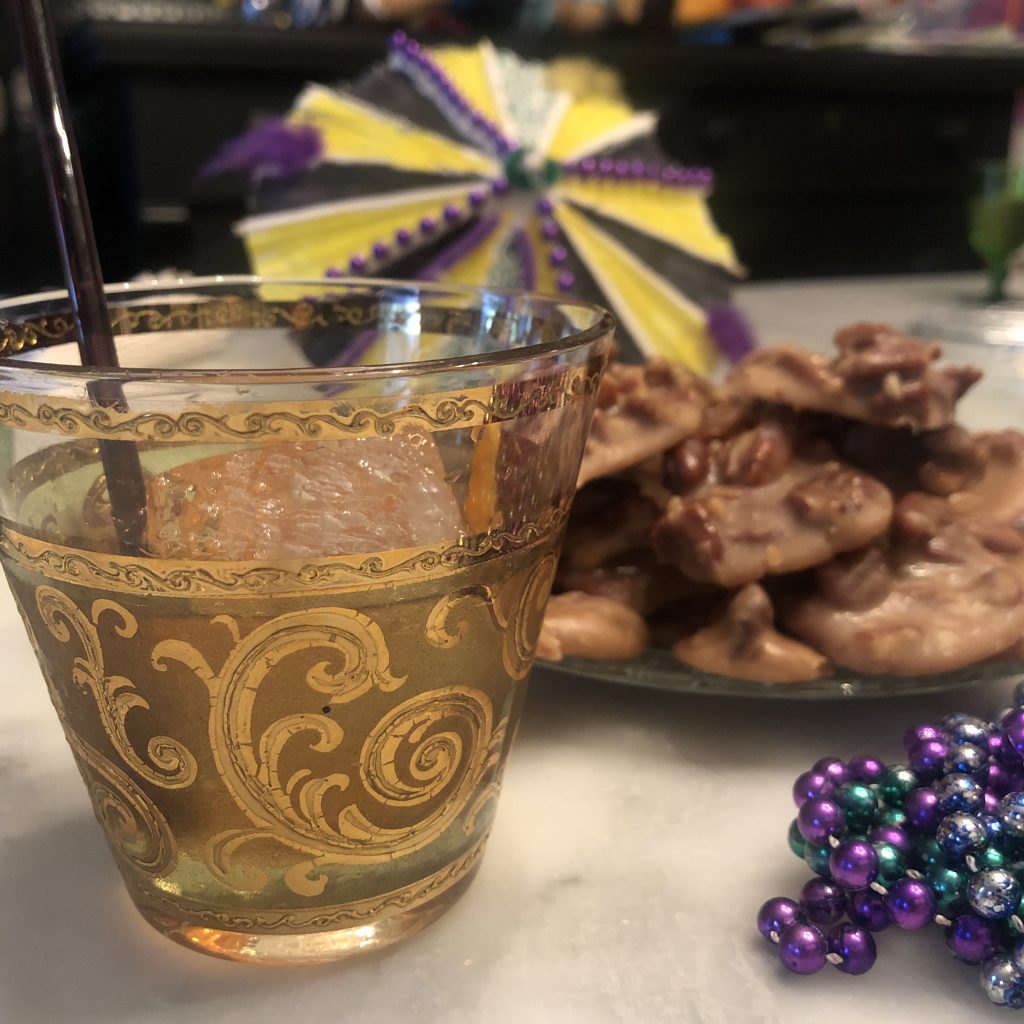
Punchbowl Sazerac
Ingredients
- 40 oz oz Old Overholt Rye
- 4 oz simple syrup
- 3 oz Herbsaint
- 30 dashes Peychauds bitters
- 30 lemon peels (or orange/clementine, or both)
- 1 ice block too fit serving container
Instructions
Make Ice Block
- To keep your cocktail cold without watering down the drink, make a block of ice at least 8-10 hours ahead so that it freezes solid. think about the size of your punch bowl or serving pitcher and make the ice so that it fits within it. Leftovers container or bowl for punch bowl, or something long and skinny for a pitcher.
Prep Cocktail
- In a large pitcher (preferably a 6-7 cup ball glass canister), pour in the Rye, simple syrup and Herbsaint. Add the dashes of bitters. Stir and taste per your liking. Put in the fridge until ready to serve.
- Make the lemon peels and keep aside in a serving bowl, covered in the fridge until ready to serve.
Serve
- Put the ice in the desired serving vessel. Stir or gently shake the cocktail mix and pour over the ice. Place the serving cups, citrus peels and additional ice cubes nearby.
- To serve, put one citrus rind in the glass and pour over the drink. Note to guests that this is a very strong drink, and that they can come by and refill as needed. Some might want to water down with the extra, regular ice cubes.
recipe
Pralines
Truly a family favorite. We will insert it right here even thought it is referenced in several other portraits on the site. They are just too good.
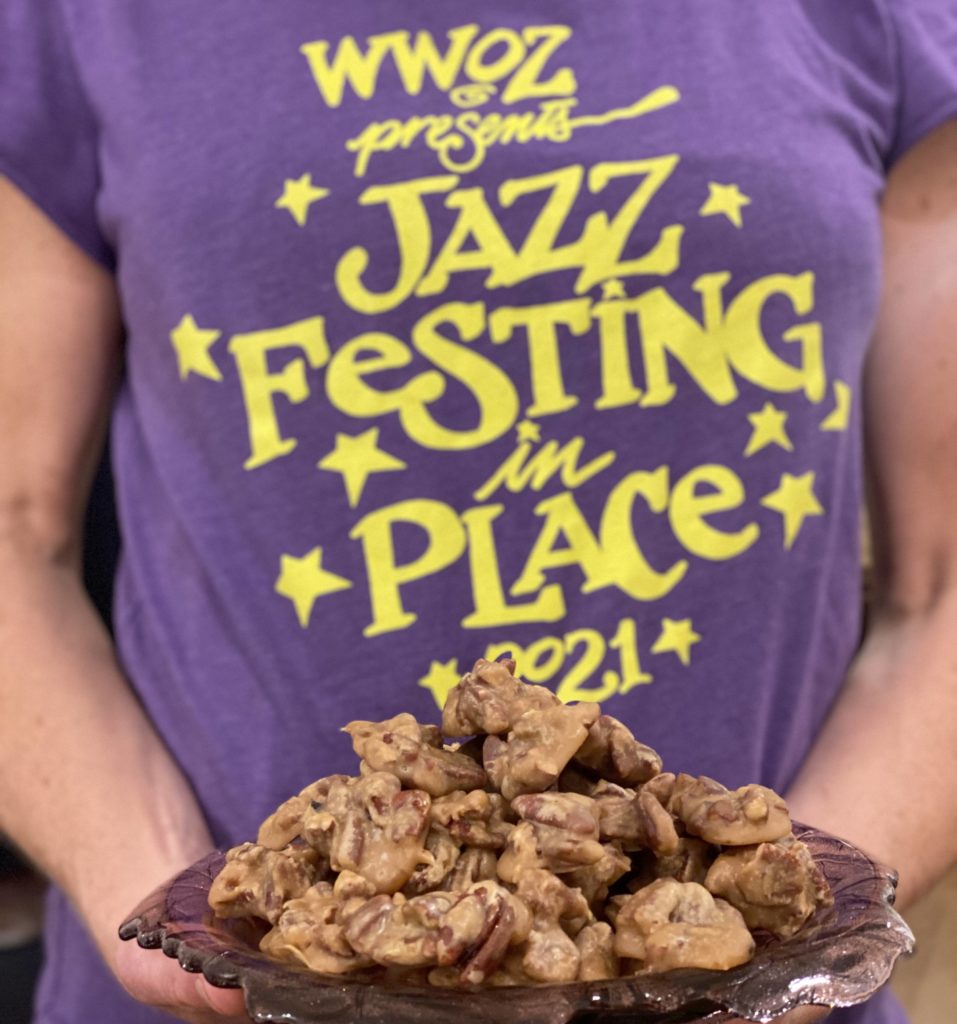
Pralines
Ingredients
- 1 1/2 cup raw pecans, in small pieces ~260g ?
- 1 rounded cup packed, light brown sugar dark works, too.
- 2/3 cup heavy cream ~155ml
- 2 tbsp salted butter ~27g
- 1 pinch salt
- 1 tsp vanilla extract
Instructions
Prep
- Break any whole pecan pieces into 3-4 pieces before measuring.
- Prepare about 12×24" of parchment paper on a heat-safe surface (I do it direct on my marble counter) and keep aside.
- Put all the ingredients EXCEPT vanilla into a large microwave-safe bowl (it tends to bubble up a bit!).
Cook
- (Note: be mindful of your microwave and it's strength! These times are for our current microwave which isn't the strongest.)
- Microwave on high, for 12-15 minutes, stirring every 2-3 minutes. It will bubble a lot!
- When the mixture starts to become thicker and darker, almost a bit cake-y, and you are afraid you have overcooked it, it's good. Add the vanilla and stir. Let stand 1 minute.
- Working quickly with 2 spoons, spoon a heaping tablespoon worth onto the parchment paper. Allow to cool fully before plating or storing.
- Stored in an air-tight container they probably last a while but I wouldn't know. We devour (and share!) them the very same day. 🙂
Bonus
Second Line Umbrellas
We brought back a classic, super-fun activity for the evening: making our own second line umbrellas! We first made them as part of our tribute (and Brooklyn second line) for the late, great Dr. John when he transitioned.

For the uninitiated, second lines are the infamous celebratory parade for festivals and celebrating life at funerals. They are, by definition, held “Dans les Rues, (in the streets), so we of course had to wrap that into the evening! Here we show you how to make your own umbrella, but really all you need is a napkin and to let your body move with the beat/energy.
The main requirement is some sort of umbrella or parasol, then you just need to decorate with whatever you have laying around:, markers, stickers, beads, scraps of string, broken necklaces, pieces of paper, tissue paper or magazines… anything works.
Second Line Umbrellas
Equipment
- glue gun & cartridges
Materials
craft supplies
- paper parasol per person (at least!)
- craft feathers (colorful & black both great)
- "mardi gras beads"
- pipe cleaners
- beads & string (optional)
- other glue-able items you may have around: felt pieces, googlie eyes, buttons, … get creative!)
tools
- glue (glue gun is best, but use what you have)
- scissors
- permanent markers work best for vivid color but crayola works
Instructions
- Prep: Clear a spot on a table or floor, and consider covering the area with newspaper or cut up trash bags, especially if you are using permanent markers.
- Decorate: First step is coloring the parasol w/ permanent markers to make a base, then glue lots of bits on as you see fit!
- Embelish: stringing beads to hang off the edges because the more they sway when you dance, the more fun your second line umbrella will be.
Red Beans and Ricely Yours,
Cultures Capsules